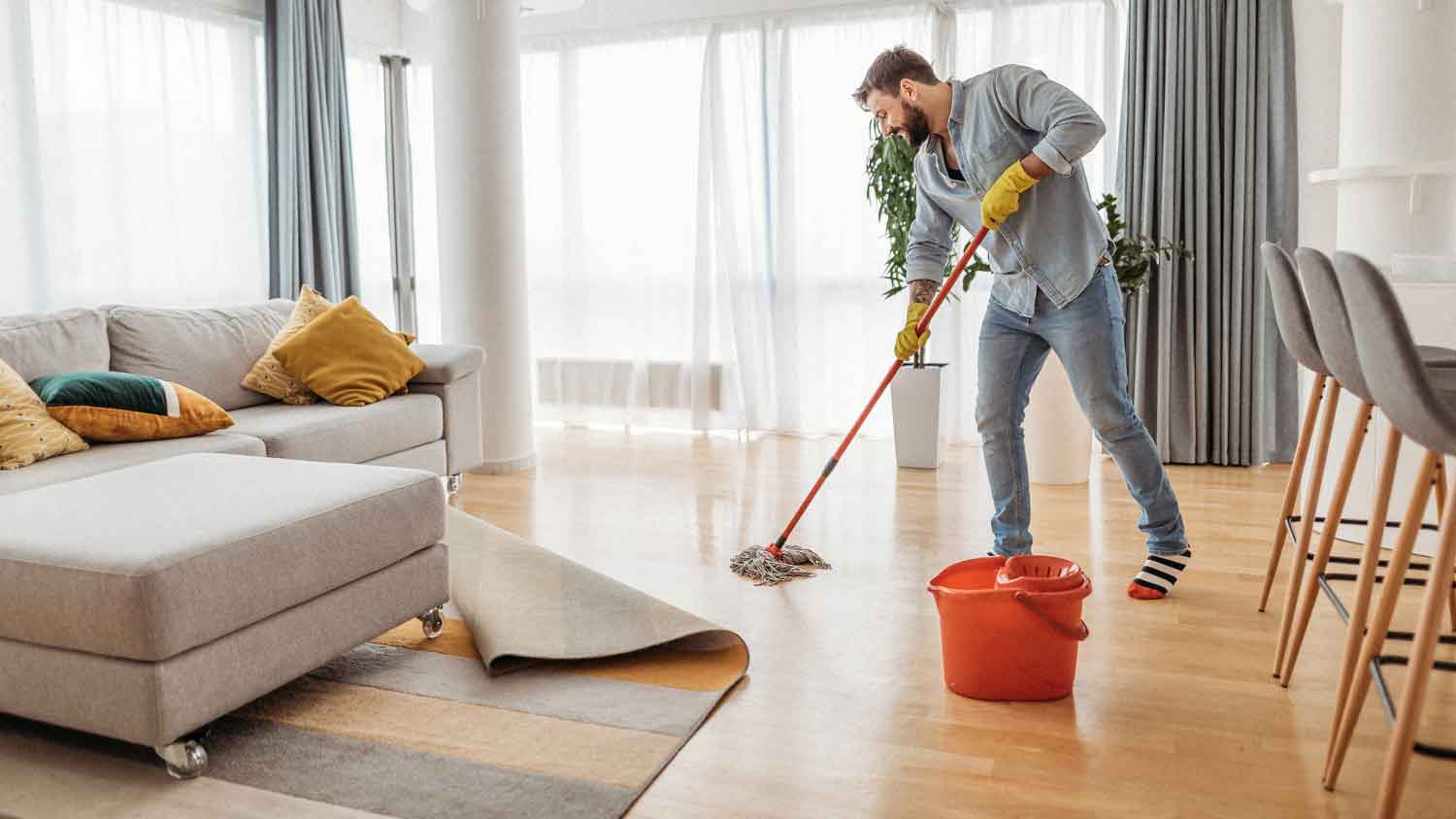Keep Your Tile Floors Clean With These 6 Tips
Floors so clean you could eat off of them...but maybe don't do that


Tile flooring is a popular choice for your bathroom and kitchen because it’s durable yet stylish. It’s also fairly easy to clean up messes from bubble baths and rogue bowls of pasta if they fall on your tile floor. And though they can withstand a lot, you’ll still have to follow a few tricks to keep your tile floors clean. We’ve rounded up a few of our favorites.
1. Use Doormats
This may seem like a no-brainer, but doormats do more than greet your guests with a fun saying—they also trap excess dirt from your family’s shoes so it doesn’t get on the tile. Dirt eats away at the surface of the tile and causes it to lose its finish over time. Stopping dirt from making it into your home is the first way to keep your tile looking beautiful.
2. Sweep Regularly
Doormats will help, but they can’t stop all dirt and buildup from making it onto your tile flooring. Sweep or vacuum at least once a week—more often if you see or feel debris on the floor—to keep grime from wearing away at the tile finish. "This cannot be stressed enough with all types of flooring," says Asya Biddle, Angi Expert Review Board member and manager of The Dust Busters janitorial company in Williamsport, PA. "The frequency a floor is swept, mopped, or vacuumed is directly correlated with the condition of the flooring."
3. Mop Up Spills Immediately
If you spill something wet or sticky, use a damp paper towel or rag to clean up right away. Addressing spills immediately prevents staining, which is much harder to get out of tile once the stain has set.
4. Wet Clean Every 1 to 2 Weeks

For tile kitchen floors, follow a cleaning schedule of mopping at least every two weeks (more frequently if your kitchen gets a lot of use). You should aim to clean tile bathroom floors at least once a week because bacteria and germs live there and spread.
5. Use the Right Cleaning Solution
Just as there are many different types of tile, there are different cleaning solutions that may be right for some materials but not others. Here’s a breakdown of how to clean each type of tile and what to avoid.
Ceramic and Porcelain Tiles
Clean with mild detergent and clean, hot water, changing the water frequently to avoid leaving a film on the floor.
Instead of a sponge mop, be sure to use a rag or chamois.
If there’s residue leftover from the soap, use a mildly acidic store-bought solution (ones that have lemon juice work nicely) to remove any soapy residue.
Dry the tiles after mopping with a clean, lint-free cloth to avoid leaving water spots.
Cork Tiles
There are different types of cork tiles, so make sure you know which one you have before you begin cleaning.
For polyurethane-sealed cork (the most frequently used material), use a solution of mild soap or white vinegar and water (1 tablespoon soap or quarter-cup vinegar per gallon of water), then go over with a water rinse.
For unfinished cork, use a solution of water and either mild soap or white vinegar (with the same ratio as above), rinse with water, then apply cork wax once the floor is dry.
Do not steam mop.
Linoleum Tiles
Sweep or vacuum first to remove dirt and debris.
Wash with store-bought linoleum flooring cleaning solution or Borax detergent and water.
Go over the flooring with a water rinse after washing.
Do not steam mop.
Apply wax and buff every three to six months to keep tiles shiny.
Stone Tiles
Avoid acidic cleaning solutions like anything with lemon juice or vinegar.
Use a mild detergent that’s pH neutral.
For polished granite tile, buff after cleaning so the floor is shiny.
For marble tile, avoid anything that might scratch the tile, such as scouring powder and brushes.
For slate tile, dry with a soft towel immediately after washing to prevent water spots.
Vinyl Tiles
Vacuum or sweep up any dirt and debris before wet cleaning.
Avoid abrasive tools like scouring powder and stiff brushes.
Mop with a water and vinegar solution (a quarter-cup of vinegar per gallon of water).
Do not steam mop.
6. Keep Up With Your Grout

Don’t neglect your grout! Grout is porous and can be difficult to keep clean because it absorbs dirt and grease. To keep your grout looking fresh:
Make your own cleaner out of baking soda and water blended together to form a paste (about a half-cup cup of baking soda and 3 tablespoons of water). Rub it on the grout and leave it overnight.
The next day, scrub with a nylon brush—be sure not to use metal, or it will damage the grout.
Use a silicone-based sealant to lock out future stains.





- Ceramic Tile Flooring Pros and Cons: Could This Be the Tile of Your Dreams?
- How Long Does Tile Flooring Last?
- What Is the Best Tile for Bathroom Floors?
- What Is the Best Tile for a Kitchen Floor?
- How to Dispose of Tile Properly
- Standard Tile Sizes: Find the Best One for Your Tile Installation Project
- 8 Tips for a Beautiful Tile-to-Wood Floor Transition
- How to Choose the Right Grout Color
- What Types of Flooring Can Be Installed Over Ceramic Tile?
- Choosing the Right Tile Spacers for Your Bathroom











